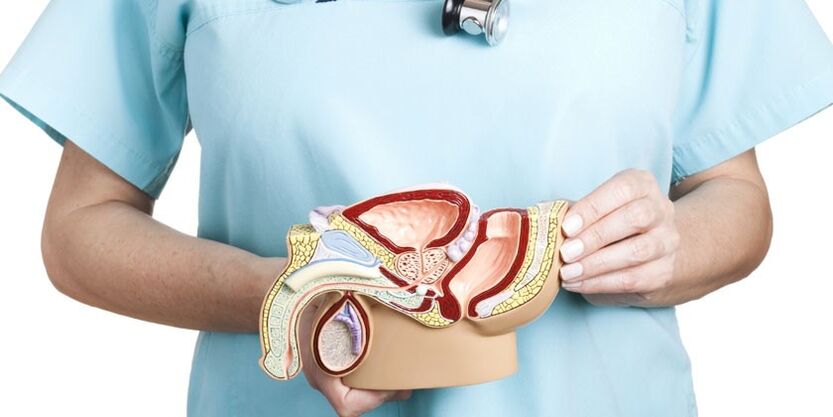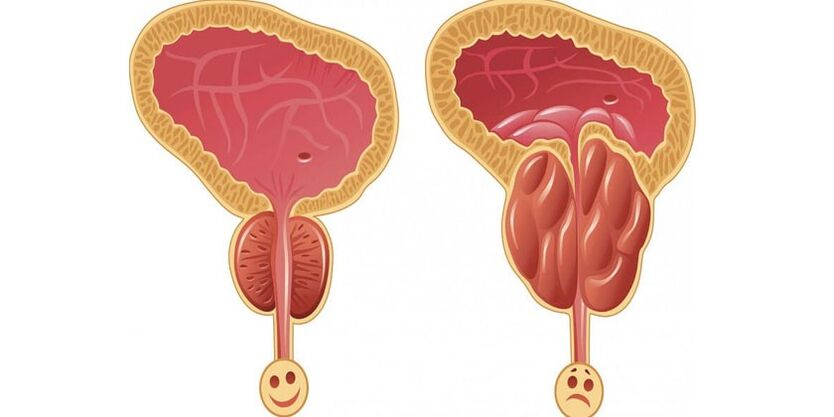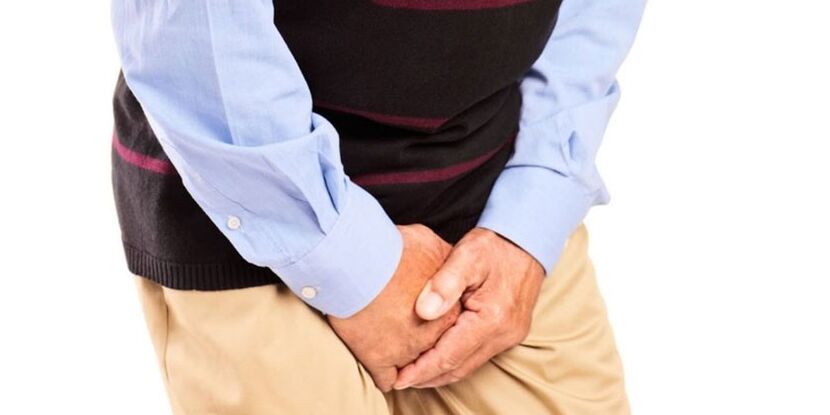According to statistics, more than 75% of men over the age of 40-45 have prostate diseases. The strong circulation of lymph and blood in the vessels of the small pelvis often provokes swelling of the organ and congestion. In addition, the prostate is well innervated, so symptoms of the disease in men include severe pain.
What is the prostate gland?
The prostate or prostate gland is the male reproductive organ, part of the reproductive system. It is located in the pelvis, below the bladder, partially covers the urethra and ejaculatory ducts. The prostate consists of two lobes and an isthmus that connects them. In addition, the upper, main, front and rear parts are distinguished in the organ. The shape of the prostate resembles a chestnut, elastic, consists of glandular and muscle cells. The prostate performs three main functions:
- Motor. Prostate muscle cells form a sphincter in the urethra that holds urine.
- Secretarial. The gland produces a special secret that provides sperm motility, liquefies sperm.
- Barrier. Prevents the spread of infection from the urethra.
Prostate disease in men
Pathologies, as a rule, are associated with damage to the organ by pathogenic and opportunistic microorganisms, congestion or neoplasms (both malignant and benign). >Among the diseases of the prostate are the following:
- inflammation (prostatitis);
- benign hyperplasia of the gland (adenoma);
- malignant neoplasm (cancer);
- cystic neoplasms;
- prostate abscess.
Many factors that create a favorable environment and conditions for the penetration and reproduction of pathogenic microorganisms (fungi, viruses, bacteria) can provoke the beginning of the development of pathology and signs of prostate inflammation in men. In addition, they can cause the development of benign or malignant tumors. Disadvantages include:
- malnutrition;
- hypovitaminosis;
- venereal diseases;
- hypothermia of the body;
- hypodynamia;
- prolonged treatment with antibiotics;
- stagnation of blood in the pelvis;
- bad habits;
- endocrine pathologies;
- pathology of the reproductive system;
- oncological diseases in the history;
- prolonged fatigue.

Symptoms of prostate disease in men
Signs of a prostate gland disorder depend on the cause of the disease, its localization and the nature of the pathological processes. As a rule, the patient complains of weakness, reduced working capacity, general fatigue and irritability. In addition, the symptoms of prostatitis and prostate adenoma in men, stones or abscess can manifest as follows:
- urination disorder;
- erectile dysfunction;
- infertility;
- pain, burning in the urethra;
- rise in temperature;
- chills;
- painful intercourse;
- lack of ejaculation;
- pain in the perineum with sudden movements;
- offensive discharge from the urethra.
prostatitis
Inflammatory damage to the prostate gland, prostatitis, is one of the most common diseases of the male genital area. The main cause of the pathology is considered to be a violation of blood circulation in the small pelvis, which leads to a strong increase in the proportions of the organ and its swelling. Symptoms of inflammation of the prostate depend on the type of disease. There are several types of pathology:
- Acute inflammation. It is caused by pathogenic microbes (eg E. coli or enterobacteria). Acute prostatitis is manifested by severe pain and pain in the urethra, impaired urination: urine is excreted with difficulty, sometimes drop by drop. Some patients report an increase in temperature.
- Chronic bacterial inflammation. As a rule, it is caused by sexual infections (chlamydia, gonorrhea, trichomoniasis, etc. ). Symptoms of chronic inflammation of the prostate may be mild or absent. Characteristic signs include sexual dysfunction (erectile dysfunction, premature ejaculation), painful urination (mainly at night) and discharge of mucus from the urethra.
- Chronic non-bacterial inflammation. The disease develops as a result of inflammatory processes in other organs (pyelonephritis, cystitis), blood stagnation, heart failure, hypothermia. Such prostatitis often has one symptom - difficulty urinating. Often the result of the pathology is a kidney disorder, discomfort in the lower back.
BPH
A disease of the prostate, characterized by benign growth of tissue and the formation of nodules, which gradually press the urethra and seminal ducts, the bladder. Hyperplasia can lead to disruption of the concentration of hormones in the blood. Signs of prostate adenoma in men vary depending on the stage of the disease:
- Compensated. As a rule, men do not notice specific symptoms at this stage. Sometimes there is an increased urge to urinate at night.
- Undercompensated. The main symptoms are a feeling of heaviness in the bladder, its incomplete emptying. Fluid during urination is difficult, patients complain of difficult ejaculation.
- Decompensated. It is characterized by a significant reduction in the volume of the bladder muscles and their tone. In addition, the adenoma develops chronic fatigue, pain and spasms when trying to urinate. In the absence of treatment, tumor growth, the intensity of pain increases significantly, defecation can be disturbed due to compression of the rectum.
Prostate adenoma is considered a precancerous disease, therefore, when this tissue growth is detected, a biopsy is needed to detect atypical cells and ultrasound (ultrasound) for a detailed study of the structure of the organ. Hyperplasia of the gland, as a rule, progresses slowly, which allows timely diagnosis and treatment.

A cyst
Under the influence of inflammatory processes of the gland, a pathological cavity with fluid or a cyst of the prostate develops, in which the excretory channels of the organ are pressed and the outflow of secretion is disturbed. Pathology can be provoked by constant stress, nervous tension, chronic diseases and tumors of neighboring organs, sclerosis of prostate tissues. Signs of a cystic formation are:
- burning in the urethra;
- increase in the size of the gland;
- decreased libido;
- increase in body temperature;
- a feeling of incomplete emptying of the bladder;
- reproductive dysfunction.
stones
The formation of stones in the prostate occurs due to a sedentary lifestyle, injuries in the groin area, inflammatory diseases of the organ. Gradually increasing in size, stones violate the integrity of the ducts of the gland, urine begins to enter the tissue of the prostate. Stones, as a rule, consist of phosphates, salts of uric and oxalic acid, protein and ductal epithelium. The main signs of pathology include:
- weak erection;
- pain when urinating;
- frequent exacerbations of inflammation;
- pain during ejaculation;
- glands in the gland and pain on probing.
Crab
A malignant neoplasm that develops from the secretory epithelium of the prostate is called cancer or carcinoma. Prolonged inflammatory processes precede tumor development. The risk group includes men over 40 who abuse alcohol and smoke. The symptoms of oncological damage to the prostate are non-specific and are manifested by a violation of the functioning of the organ. In the early stages, the disease is usually not manifested. As the tumor develops, the following symptoms develop:
- hematuria;
- painful urination;
- pain in the lower abdomen;
- swelling of the legs;
- chair violation;
- impotence.
Abscess
An infectious-inflammatory pathology, which is accompanied by purulent spillage of tissues, is called an abscess. Such a process develops due to the transfer of pathogenic bacteria from the primary focus of infection to the prostate gland through the bloodstream. For a long time, the abscess can be asymptomatic. The main signs of the presence of a purulent focus in the tissues of the prostate are: >
- fever and chills;
- pain during intercourse, urination;
- discharge of foul-smelling pus in the urine (when the abscess ruptures).
Purulent formations in the prostate are diagnosed using instrumental and laboratory tests. Blood tests show an increase in the number of leukocytes, an increase in the value of the erythrocyte sedimentation rate. Urine examination reveals leukocyturia and pathogenic microflora. During a palpation examination through the rectum, the presence of a rounded formation is established.

The main methods of treatment of the prostate gland
Pathology treatment methods depend on the specific disease, its stage and severity. Therapy for prostate diseases is selected individually, depending on the age of the patient, the results of laboratory tests, instrumental tests, the presence of concomitant pathologies. Get to know the basic principles of prostate disease treatment:
disease |
Methods of treatment |
|---|---|
prostatitis |
|
Adenoma |
|
A cyst |
|
stones |
|
Crab |
|
Abscess |
|
Prevention
To prevent the development of prostate diseases, you must follow the principles of a healthy lifestyle. Reduces the risk of prostate pathologies by following the recommendations:
- Stick to a balanced diet.
- Exercise regularly.
- Take multivitamin complexes, immunomodulatory drugs.
- Refrain from drinking alcohol, smoking tobacco, drugs.
- Avoid hypothermia.
- See your doctor as soon as symptoms appear.

























